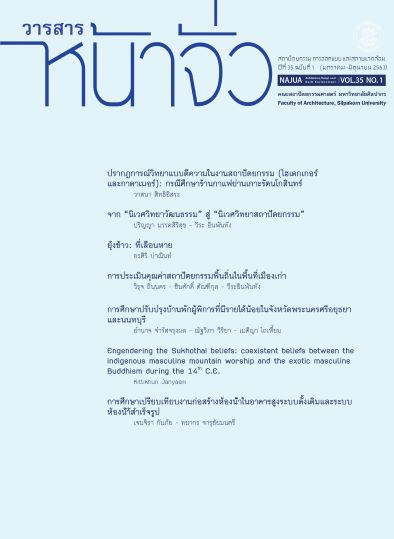A Study of Housing Modifications for Low-Income People with Disabilities in Ayutthaya and Nonthaburi
Keywords:
People with Disabilities, Accessible Home, Home Modification, Low-Income, Supportive and safeAbstract
A supportive and safe environment is a significant contributor to residents’ well-being, which can provides comfortable travel to their desirable places both inside and outside their residential areas. However, elderly people with disabilities spend their everyday life with other people in homes that do not meet their requirements, meaning that they encounter difficulties when moving and travelling, and this results in caregiver burden. Providing a supportive and safe environment and accessible houses to different residents is challenging. Major challenges are composed of the limited financial support, the strength of housing structure, and the standard public accommodation that are not accessible for disabled people. These varied phenomena cannot be solved with application of architectural and engineering theory.
The study revealed that housing conditions of disabled low-income people in Ayutthaya and Nonthaburi were similar in the tenure of the dwelling in which people live. In Nonthaburi, the percentage of people with ambulatory disabilities was 45 percent, 25 percent for those with multiple disabilities, 15 percent for those with cognitive disabilities, and 15 percent for those with vision disabilities. Their housing was built of a mixture of wood and concrete. The immediate priorities of home modifications were bathroom, bedroom. The majority of people with disabilities in Nonthaburi mainly accessed basic standards of living, while those in Ayutthaya, who had lower incomes, were living in a home that fails to fully meet their needs. In Ayutthaya, disabled people with the highest percentages were ambulatory at 45 percent. People with vision disabilities were 35 percent, and 20 percent for elderly and long-term bed-ridden. Their most needed home modifications were bathroom, roof, and entrance ladder, respectively. Natural disaster that annually occurred was a major factor leading to roof repairs and damaged ladder due to long term water submersion.
When looking to the future for further study, new strategies and design features need to be created for home modification in compliance with limited funds and suitability of space utilization. This includes financial budget, materials, approaches, and new innovations in order to meet the needs of people with disabilities in the future.
References
- B, Duerstock. (2001). Tips on Building an Accessible Home. North Carolina State University: Centre for Universal Design. from https://web.ics.purdue.edu/~bsd/building.html.
- Pradabsook B. (2014). Kho naenam kan okbaep sing amnuai khwam saduak samrap thuk khon. (in Thai) [Buildings and Environments Design Recommendation for all]. Bangkok: The Association of Siamese Architects under the Royal Patronage.
- Department of Empowerment of Persons with Disabilities. (2019)Rai-ngan Khomun Sathankan dan Khonphikan nai Prathet Thai Krasuang Kanphatthana sangkhom lae Khwammankhong khong manut. (in Thai) [Report of the situation of the disabled in Thail: Ministry of Social Development and Human Security]. Retrieved April 01, 2019, from https://www.m-society.go.th/news_view.php?nid=802
- Edward Steinfeld, Jordana Maisel. (2012). Universal Design: Creating Inclusive Environments. NJ: Wiley.
- Jarutach T. (2014). Kan okbaep phua thuk khon. (in Thai) [Universal Design]. Bangkok: Chulalongkorn University Printing House.
- Julius Panero and Martin Zelnik. (1979). Human dimension & interior space: a source book of design reference standards. New York: Random House, Inc.
- Ronald Mace. (1997). The principles of universal design (Version 2.0). Center for Universal Design. Ireland: National Disability Authority.
- Social Development and Human Security office of Ayutthaya. (2019). Rai-ngan khomun dan khonphikan. (in Thai) [Report of for Disabled People in Ayutthaya Province]. Retrieved May 07, 2019, from http://www.ayutthaya.m-society.go.th/
- Social Development and Human Security office of Ayutthaya. (2019). Sathiti khomun khonphikan thi mi bat pracham tua khonphikan changwat nonthaburi chamnaek tam praphet khwam phikan læ phet. (in Thai) [Statistics of Disabled Persons with Identification Cards for Disabled People in Nonthaburi Province]. Retrieved June 30, 2019, from http://www.nonthaburi.m-society.go.th/?page_id=7095
- Sukhothai Thammathirat Open University. (1988) Kan dulae bukkhon phikan. (in Thai) [Care of the Handicapped]. Nonthaburi: Sukhothai Thammathirat.
- The Association of Siamese Architects under the Royal Patronage. (2010). Khumu patibat wichachip kan okbaep saphapwætlom lae sing amnuai khwam saduak samrap thuk khon. (in Thai) [Professional Practice Manual: Building and Environments Design Recommendation for All]. Bangkok: Pluss Press Co.,th





